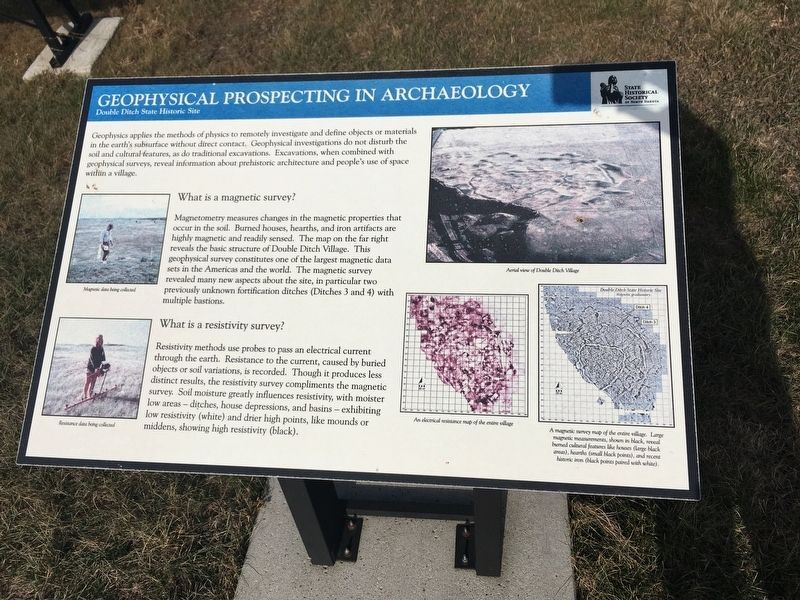Bismarck in Burleigh County, North Dakota — The American Midwest (Upper Plains)
Geophysical Prospecting in Archaeology
Geophysics applies the methods of physics to remotely investigate and define objects or materials in the earth's subsurface without direct contact. Geophysical investigations do not disturb the soil and cultural features, as do traditional excavations. Excavations, when combined with geophysical surveys, reveal information about prehistoric architecture and people's use of space within a village.
What is a magnetic survey?
Magnetometry measures changes in the magnetic properties that occur in the soil. Burned houses, hearths, and iron artifacts are highly magnetic and readily sensed. The map on the far right reveals the basic structure of Double Ditch Village. This geophysical survey constitutes one of the largest magnetic data sets in the Americas and the world. The magnetic survey revealed many new aspects about the site, in particular two previously unknown fortification ditches (Ditches 3 and 4) with multiple bastions.
What is a resistivity survey?
Resistivity methods use probes to pass an electrical current through the earth. Resistance to the current, caused by buried objects or soil variations, is recorded. Though it produces less distinct results, the resistivity survey compliments the magnetic survey. Soil moisture greatly influences resistivity, with moister low areas – ditches, house depressions, and basins – exhibiting low resistivity (white) and drier high points, like mounds or middens, showing high resistivity (black).
Captions:
Magnetic data being collected
Resistance data being collected
Aerial view of Double Ditch Village
An electrical resistance map of the entire village
A magnetic survey map of the entire village. Large magnetic measurements, shown in black, reveal burned cultural features like houses (large black areas), hearths (small black points), and recent historic iron (black points paired with white).
Erected by State Historical Society of North Dakota.
Topics. This historical marker is listed in these topic lists: Anthropology & Archaeology • Native Americans • Science & Medicine.
Location. 46° 56.047′ N, 100° 53.894′ W. Marker is in Bismarck, North Dakota, in Burleigh County. Marker can be reached from Double Ditch Loop (State Highway 1804). Touch for map. Marker is in this post office area: Bismarck ND 58503, United States of America. Touch for directions.
Other nearby markers. At least 8 other markers are within walking distance of this marker. Missouri River Resources (within shouting distance of this marker); Ditch 2 (within shouting distance of this marker); Double Ditch State Historic Site (within shouting distance of this marker); Final Occupation of Double Ditch (about 300 feet away, measured in a direct line); Ditch 3 (about 400 feet away); Archaeological Excavations in 1905 (about 500 feet away); Midden Mounds (Trash Heaps) (about 500 feet away); Homes (about 700 feet away). Touch for a list and map of all markers in Bismarck.
Also see . . . Double Ditch State Hist. Site. (Submitted on January 10, 2021, by Connor Olson of Kewaskum, Wisconsin.)
Credits. This page was last revised on April 11, 2022. It was originally submitted on January 10, 2021, by Connor Olson of Kewaskum, Wisconsin. This page has been viewed 100 times since then and 5 times this year. Photo 1. submitted on January 10, 2021, by Connor Olson of Kewaskum, Wisconsin. • Bill Pfingsten was the editor who published this page.
